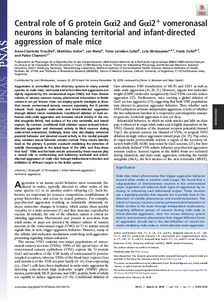Por favor, use este identificador para citar o enlazar este ítem:
https://repositorio.uca.edu.ar/handle/123456789/8682| Campo DC | Valor | Lengua/Idioma |
|---|---|---|
| dc.contributor.author | Trouillet, Anne-Charlotte | es |
| dc.contributor.author | Keller, Matthieu | es |
| dc.contributor.author | Weiss, Jan | es |
| dc.contributor.author | Leinders-Zufall, Trese | es |
| dc.contributor.author | Birnbaumer, Lutz | es |
| dc.contributor.author | Zufall, Frank | es |
| dc.contributor.author | Chamero, Pablo | es |
| dc.date.accessioned | 2019-09-03T22:17:20Z | - |
| dc.date.available | 2019-09-03T22:17:20Z | - |
| dc.date.issued | 2019 | - |
| dc.identifier.citation | Trouillet A-C, Keller M, Weiss J, et al. Central role of G protein Gαi2 and Gαi2+ vomeronasal neurons in balancing territorial and infant-directed aggression of male mice [en línea]. Proceedings of the National Academy of Sciences. 2019;116(11):5135-5143. doi:10.1073/pnas.1821492116 Disponible en: https://repositorio.uca.edu.ar/handle/123456789/8682 | es |
| dc.identifier.issn | 0027-8424 (print) | - |
| dc.identifier.issn | 1091-6490 (online) | - |
| dc.identifier.uri | https://repositorio.uca.edu.ar/handle/123456789/8682 | - |
| dc.description.abstract | Abstract: Aggression is controlled by the olfactory system in many animal species. In male mice, territorial and infant-directed aggression are tightly regulated by the vomeronasal organ (VNO), but how diverse subsets of sensory neurons convey pheromonal information to limbic centers is not yet known. Here, we employ genetic strategies to show that mouse vomeronasal sensory neurons expressing the G protein subunit Gαi2 regulate male-male and infant-directed aggression through distinct circuit mechanisms. Conditional ablation of Gαi2 enhances male-male aggression and increases neural activity in the medial amygdala (MeA), bed nucleus of the stria terminalis, and lateral septum. By contrast, conditional Gαi2 ablation causes reduced infant-directed aggression and decreased activity in MeA neurons during male-infant interactions. Strikingly, these mice also display enhanced parental behavior and elevated neural activity in the medial preoptic area, whereas sexual behavior remains normal. These results identify Gαi2 as the primary G protein α-subunit mediating the detection of volatile chemosignals in the apical layer of the VNO, and they show that Gαi2+ VSNs and the brain circuits activated by these neurons play a central role in orchestrating and balancing territorial and infant-directed aggression of male mice through bidirectional activation and inhibition of different targets in the limbic system. | es |
| dc.format | application/pdf | - |
| dc.language.iso | eng | es |
| dc.publisher | National Academy of Sciences | es |
| dc.rights | Acceso Abierto | * |
| dc.rights.uri | http://creativecommons.org/licenses/by-nc-sa/4.0/ | * |
| dc.source | Proceedings of the National Academy of Sciences. 2019;116(11):5135-5143 | es |
| dc.subject | TERRITORIALIDAD | es |
| dc.subject | AGRESIVIDAD | es |
| dc.subject | PROTEINAS | es |
| dc.subject | COMPORTAMIENTO | es |
| dc.subject | SISTEMA LIMBICO | es |
| dc.title | Central role of G protein Gαi2 and Gαi2+ vomeronasal neurons in balancing territorial and infant-directed aggression of male mice | es |
| dc.type | Artículo | es |
| dc.identifier.doi | 10.1073/pnas.1821492116 | - |
| dc.identifier.pmid | 30804203 | - |
| uca.disciplina | MEDICINA | - |
| uca.issnrd | 1 | es |
| uca.affiliation | Fil: Trouillet, Anne-Charlotte. University of Tours. Institut Français du Cheval et de l’Equitation. Institut National de la Recherche Agronomique. Laboratoire de Physiologie de la Reproduction et des Comportement; Francia | es |
| uca.affiliation | Fil: Keller, Matthieu. University of Tours. Institut Français du Cheval et de l’Equitation. Institut National de la Recherche Agronomique. Laboratoire de Physiologie de la Reproduction et des Comportement; Francia | es |
| uca.affiliation | Fil: Weiss, Jan. Saarland University. Center for Integrative Physiology and Molecular Medicine; Alemania | es |
| uca.affiliation | Fil: Leinders-Zufall, Trese. Saarland University. Center for Integrative Physiology and Molecular Medicine; Alemania | es |
| uca.affiliation | Fil: Birnbaumer, Lutz. Research Triangle Park. National Institute of Environmental Health Sciences. Neurobiology Laboratory; Estados Unidos | es |
| uca.affiliation | Fil: Birnbaumer, Lutz. Pontificia Universidad Católica Argentina. Facultad de Ciencias Médicas. Instituto de Investigaciones Biomédicas; Argentina | es |
| uca.affiliation | Fil: Zufall, Frank. Saarland University. Center for Integrative Physiology and Molecular Medicine; Alemania | es |
| uca.affiliation | Fil: Chamero, Pablo. University of Tours. Institut Français du Cheval et de l’Equitation. Institut National de la Recherche Agronomique. Laboratoire de Physiologie de la Reproduction et des Comportement; Francia | es |
| uca.version | publishedVersion | es |
| item.fulltext | With Fulltext | - |
| item.grantfulltext | open | - |
| item.languageiso639-1 | en | - |
| crisitem.author.dept | Instituto de Investigaciones Biomédicas - BIOMED | - |
| crisitem.author.dept | Laboratorio de Función y Farmacología de Canales Iónicos | - |
| crisitem.author.dept | Consejo Nacional de Investigaciones Científicas y Técnicas | - |
| crisitem.author.dept | Facultad de Ciencias Médicas | - |
| crisitem.author.orcid | 0000-0002-0775-8661 | - |
| crisitem.author.parentorg | Facultad de Ciencias Médicas | - |
| crisitem.author.parentorg | Instituto de Investigaciones Biomédicas - BIOMED | - |
| crisitem.author.parentorg | Pontificia Universidad Católica Argentina | - |
| Aparece en las colecciones: | Artículos | |
Ficheros en este ítem:
| Fichero | Descripción | Tamaño | Formato | |
|---|---|---|---|---|
| central-role-of-g-protein.pdf | 1,71 MB | Adobe PDF |  Visualizar/Abrir |
Visualizaciones de página(s)
259
comprobado en 05-nov-2025
Descarga(s)
184
comprobado en 05-nov-2025
Google ScholarTM
Ver en Google Scholar
Altmetric
Altmetric
Este ítem está sujeto a una Licencia Creative Commons

